Barcelona Femení have so far been one of this season’s standout teams in European women’s football, winning all 13 Primera División games to date, as well as securing the top spot in their Champions League group with six wins from six. Across both competitions, they have scored a total of 99 goals and conceded just five, while their play has been seemingly effortless at times. This comes down to the players performing well on matchdays, but it is also due to the tactical ideas that head coach Jonatan Giráldez has asked his team to buy into, following his appointment as Lluís Cortés’ successor in the summer.
This tactical analysis will look at the way in which Giráldez has set his team up this season, finding the reasons why they’ve been simply unstoppable so far. The analysis will focus on how they create options in attacking situations, how their midfield plays an essential role in their preferred style of play, and how their defensive work has made them hard to beat.
Creating passing options
The biggest thing to look at is how Barcelona Femení create options in attack, and it is important to note that there hasn’t been a lot of change in this part of their game, as Jonatan Giráldez was Lluís Cortés’ assistant last season, so the basics of their attack are largely the same.
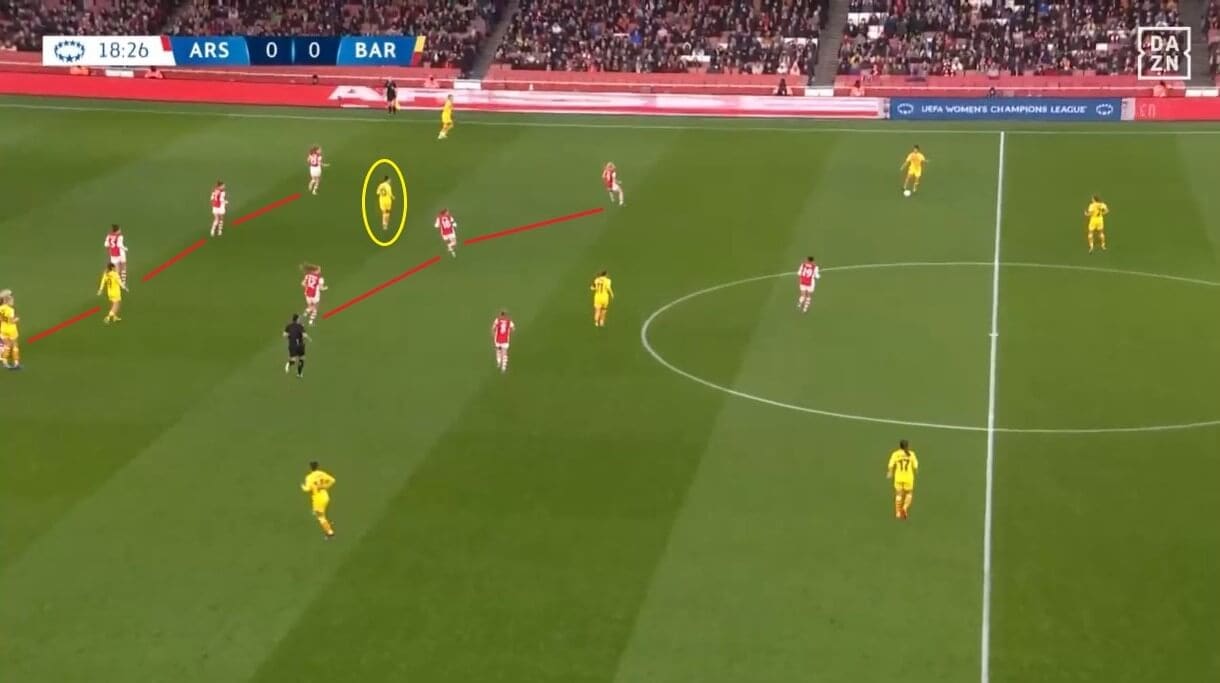
Firstly, they have a good knowledge of where the spaces are, which is a key ingredient in successfully breaking teams down. Here, in their Champions League win against Arsenal Women at the Emirates Stadium in October, Spain striker Jennifer Hermoso has positioned herself between the defence and midfield, which gives Arsenal a problem. Their wide structure, caused by Barcelona spreading out across the pitch, has left gaps open between each of the players, and Hermoso is in the perfect space to receive the ball and move it forward to a teammate, making her very dangerous in this situation.
Last season, it was the most notable feature of their attacking play to see Hermoso dropping into these spaces, which then allowed the midfielders to run beyond her. Chelsea Women, in particular, were caught out by this in last season’s Champions League final. However, when in matches where they need to play with a striker who will stay on the defenders’ shoulders, Barcelona will instead deploy Nigeria captain Asisat Oshoala, so they have a good range of options available, and this is something that has really helped them. Again, Giráldez has not altered their tactics that much in this area, with this continuation a key reason for their strong campaign so far.
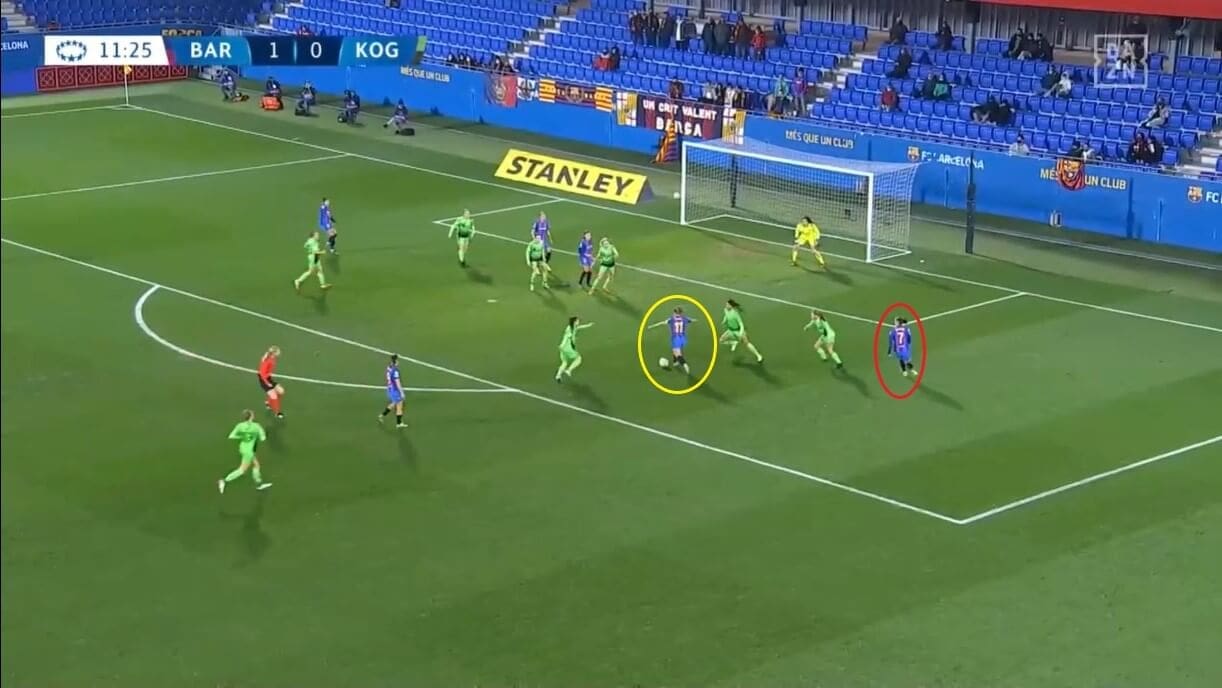
However, one thing he has done is create more attacking overloads in the box. Under Cortés, we tended to see Spain midfielders Aitana Bonmatí and Alexia Putellas get behind defenders, as mentioned, but they were often left on their own and lacked support when they occasionally needed it. However, Giráldez has pushed more players into these areas, giving them a greater goalscoring threat. With this many players packed into this area, they have made more short passes and opened up gaps, such as here, with Norway forward Caroline Graham Hansen, in the red circle, finding Putellas in the middle. Once the midfielder’s effort is saved, Clàudia Pina is there to tap in the rebound and whilst it was given as offside, this shows how Giráldez’s tactical tweak has helped his side to become more aggressive in the final third.
This has been particularly useful against teams like Danish champions HB Køge, Barcelona’s opponents here, as they constantly looked to make it hard for attackers to break them down. Barcelona’s ability to open up opponents by getting more players forward has therefore helped, and the fact that their expected goals (xG) per game value has gone up to 4.45, compared to 4.01 last season, reflects this improvement in their play.
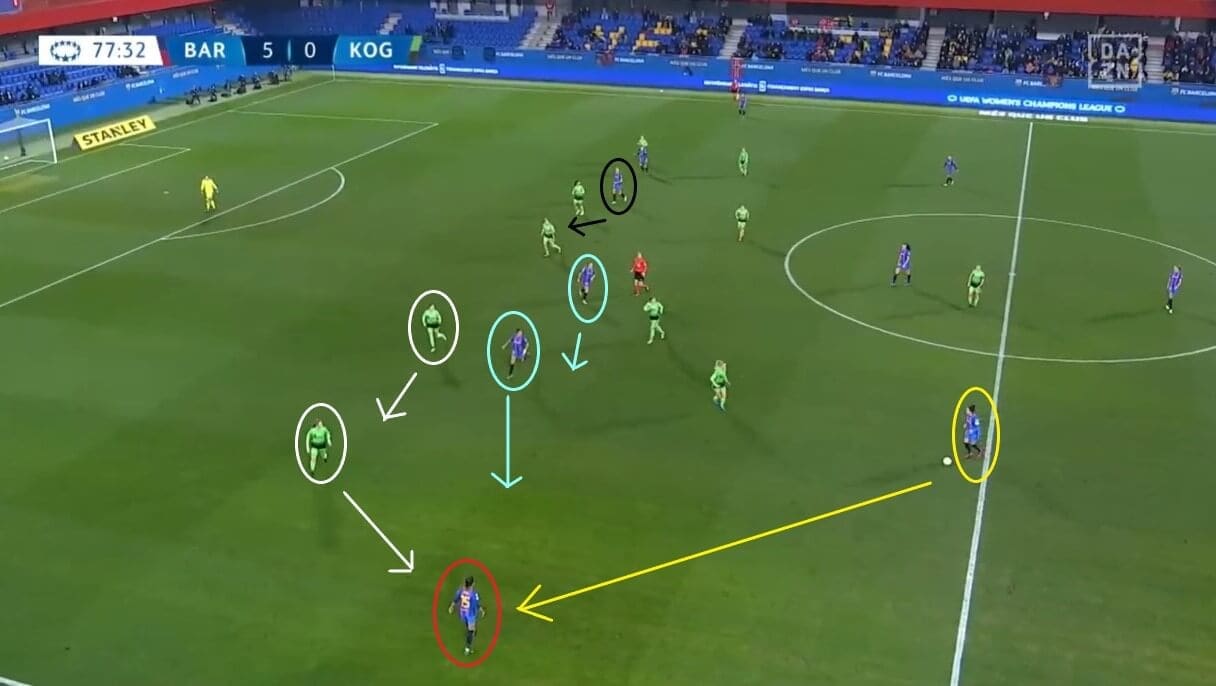
As mentioned, Køge made their opponents work hard during the Champions League group stages, but Barcelona’s passing ability and good anticipation meant that their players were always in the right positions to help find ways through. Defender Melanie Serrano is passing to left-back Leila Ouahabi here, as shown by the yellow arrow, and the white arrows illustrate how the Køge defenders instinctively move towards the ball once this pass has been made.
However, Ouahabi passes back to Serrano immediately after touching the ball, with this small sequence having the desired effect of dismantling Køge’s defensive structure. Now, there is a gap that Barcelona can exploit, with Sweden striker Fridolina Rolfö, who joined from Wolfsburg Frauen in the summer, making a run through the line to get onto the end of Serrano’s aerial pass, as highlighted by the black arrow. Another thing that helped here was Barcelona’s central players making small movements in front of the defence, taking their focus off the ball, so this again shows how the whole team works together to create spaces.
Barcelona’s overall attacking play has not changed much under Giráldez, with his preferred tactics being very similar to Cortés’, and this means that players have not had to make many individual adjustments, which has been a key factor in their continued dominance.
The midfielders’ roles
When we turn our focus to the midfielders, we can see how they play a vital role in Barcelona Femení’s ball movement, providing a link between the defence and attack, and their adaptable structure is something that Jonatan Giráldez has noticeably worked on since taking over.
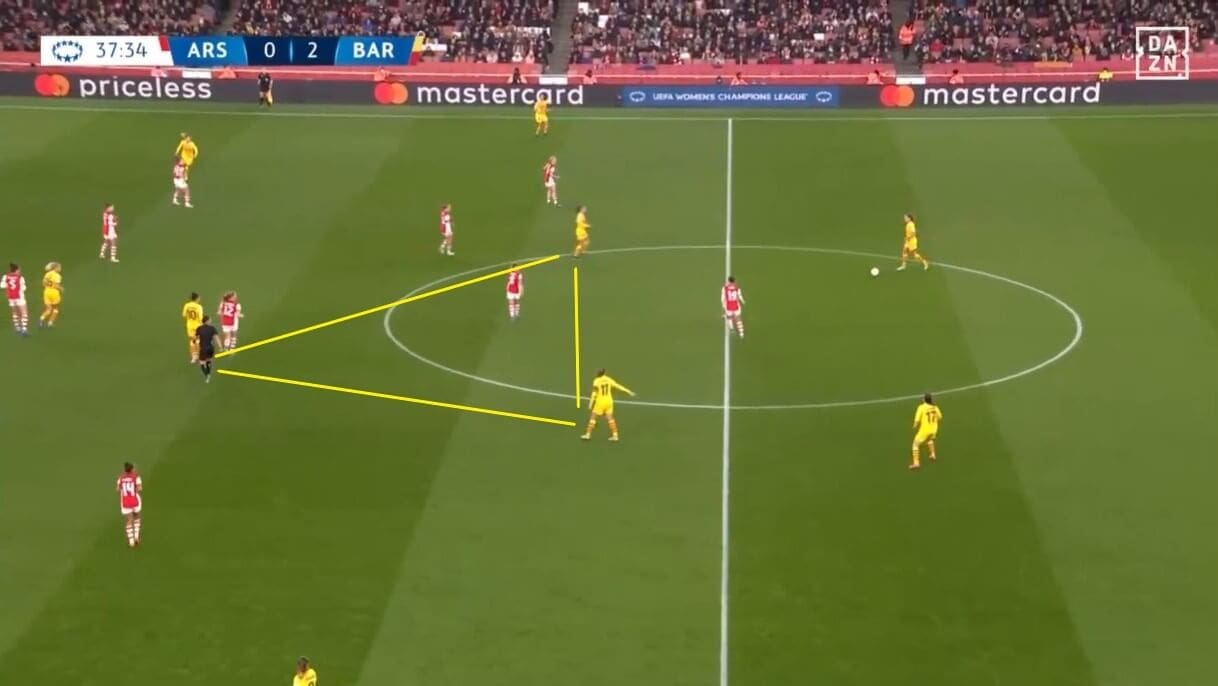
Under Lluis Cortés, Barcelona’s two main formations were 4-1-4-1 and 4-3-3, with the latter being used 51% of the time. However, under Giráldez, they have used the 4-3-3 regardless of who their opponents are, with its usage increasing to 79%, and this has helped individual players to get used to different jobs during games, again helping the whole team to become slicker with the ball and harder to play against.
The midfield has become their engine room, with whichever players are in this third responsible for creating passing options around the pitch. This means that they need to have a flexible structure, and it is common to see two midfielders at the front when Barcelona are attacking, with one staying back to protect the defence in case of a counter-attack, but then one of the two midfielders will drop back when the defenders have the ball, as is the case here, with one player left in the playmaker role. This ability to switch the focus of the midfield at will has been a major factor in Barcelona’s excellent ball retention under Giráldez, and their passing accuracy has also slightly increased, going up by 0.04% from last season, so this is a change that has worked for them.
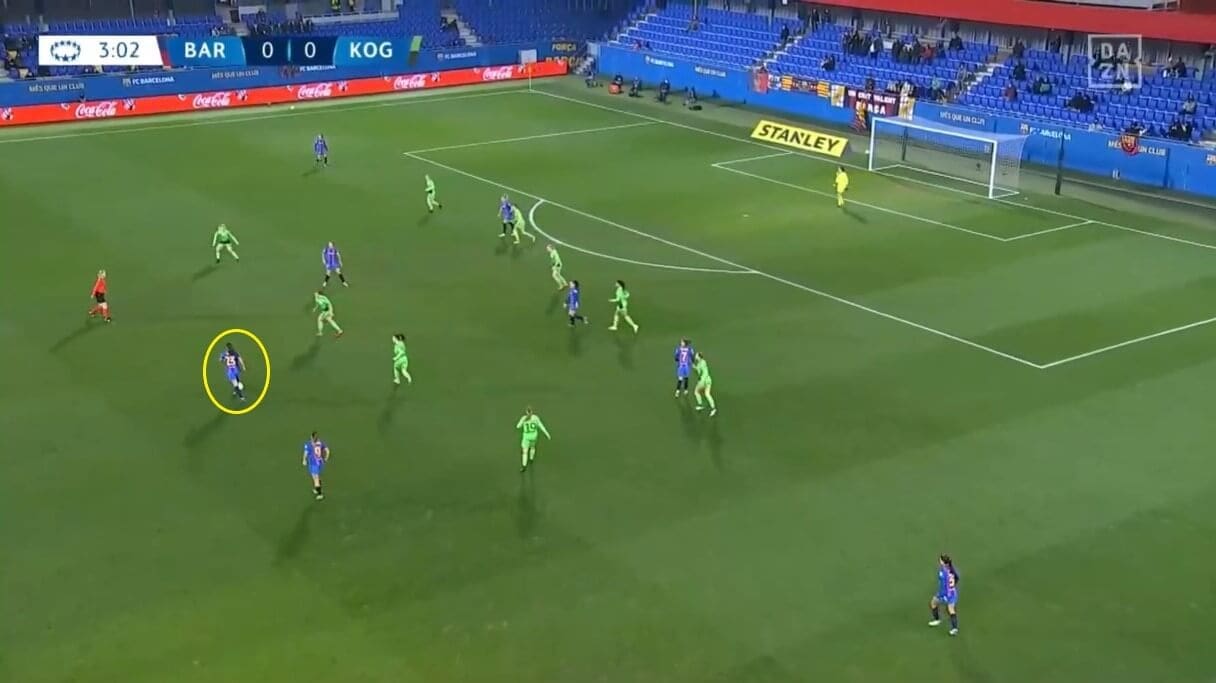
If we break this down, we can see why each job is important to Barcelona’s overall game plan. In the holding midfield role, they need to have a player who will see spaces, link up different areas of the team and help to move the ball around the pitch, and this is where summer signing Ingrid Engen, who also joined from Wolfsburg, comes in. The Norway international has fitted into the gap left by the departures of Vicky Losada to Manchester City Women and Kheira Hamraoui to PSG Feminine, offering the defensive protection that has allowed others to get forward and create added problems for their opponents.
As mentioned, this player also needs to be good at finding teammates and creating opportunities in the final third from further out, with France international Hamraoui known last season for making long diagonal passes to switch the play. Whilst Engen doesn’t make as many aerial passes, she is in the middle of the pitch here, looking for teammates and trying to help move the ball through Køge’s low block.
We have already analysed Barcelona’s attacking overloads, but having a player like Engen who can sit back and also link up the play in different ways is what has allowed them to get more players into advanced areas, and this is another thing that Giráldez has altered to help Barcelona be a more efficient side this season.
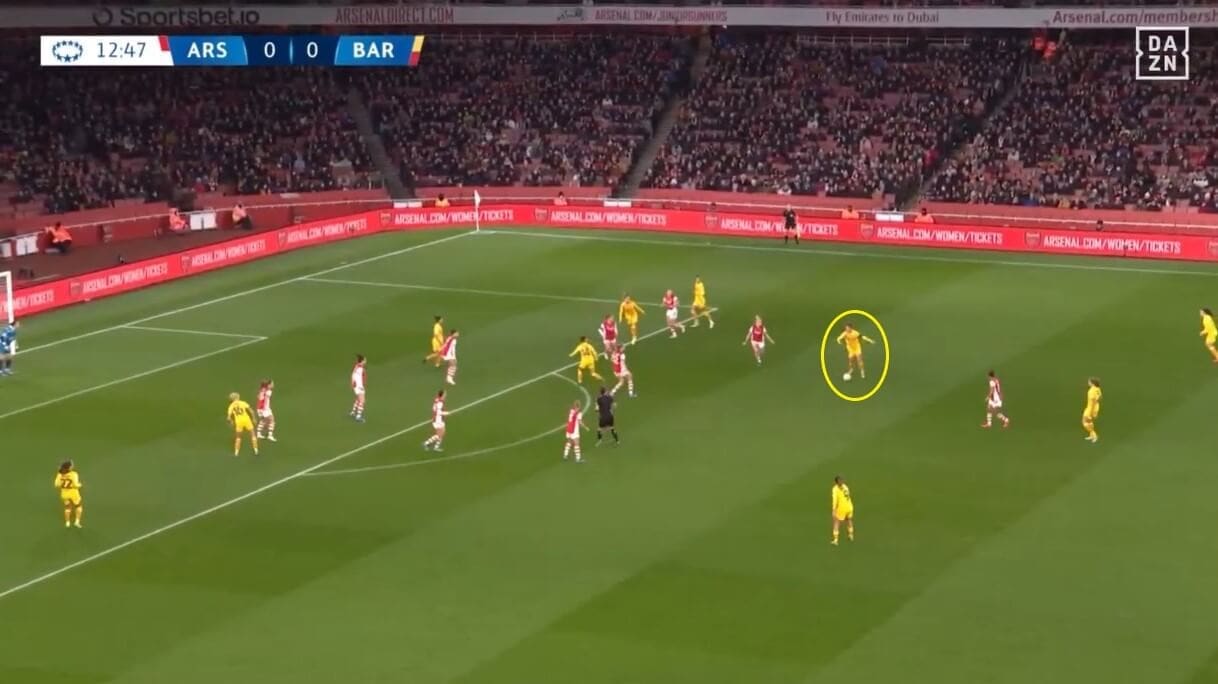
At the other end of the midfield, we generally find Bonmatí or newly-crowned Ballon d’Or Feminine winner Putellas getting between opposing defenders, with both capable of operating as a playmaker. Here, it is Putellas who has positioned herself between three Arsenal players and is now looking to set up a chance for her teammates to get a shot away at goal. Last season, she was arguably Barcelona’s most important player, with her range of passing allowing her to get involved in quick interplay with teammates, whilst she can also make incisive passes through narrow gaps, so always poses a threat when left in areas like this, and her presence is critical for Barcelona to successfully break through opposing defences. This role was a key aspect of Cortés’ tactics last season, but their 1.1% increase in accuracy of passes to the final third shows how Giráldez has used and relied on it even more as a way of helping his team to build attacks.
However, another change that Giráldez has made this season is to not always deploy his players in their regular positions. To explain, Putellas has occasionally been in a more defensive midfield role, whilst Rolfö, Switzerland international Ana-Maria Crnogorčević and Mariona Caldentey, normally all forwards, have spent time as full-backs, and Jennifer Hermoso has started in the midfield in a couple of matches. The theory is that Barcelona will be a little less predictable with these different setups, because their opponents won’t know which player will take up each role, making it harder for them to come up with a coherent game plan.
It is interesting because this is one of the basic principles of Johan Cruyff’s Total Football philosophy, with every player able to play in every position apart from in goal, and Giráldez’s decision to introduce it into the team this season is another reason for their play looking so sharp under him.
Defensive setup
Whilst we have focused a lot on Barcelona Femení’s attack in this article, their defence has also been key to their successful season so far. As mentioned, they have only conceded five goals in the league and Champions League at the time of writing, becoming a tougher team for opponents to break down.
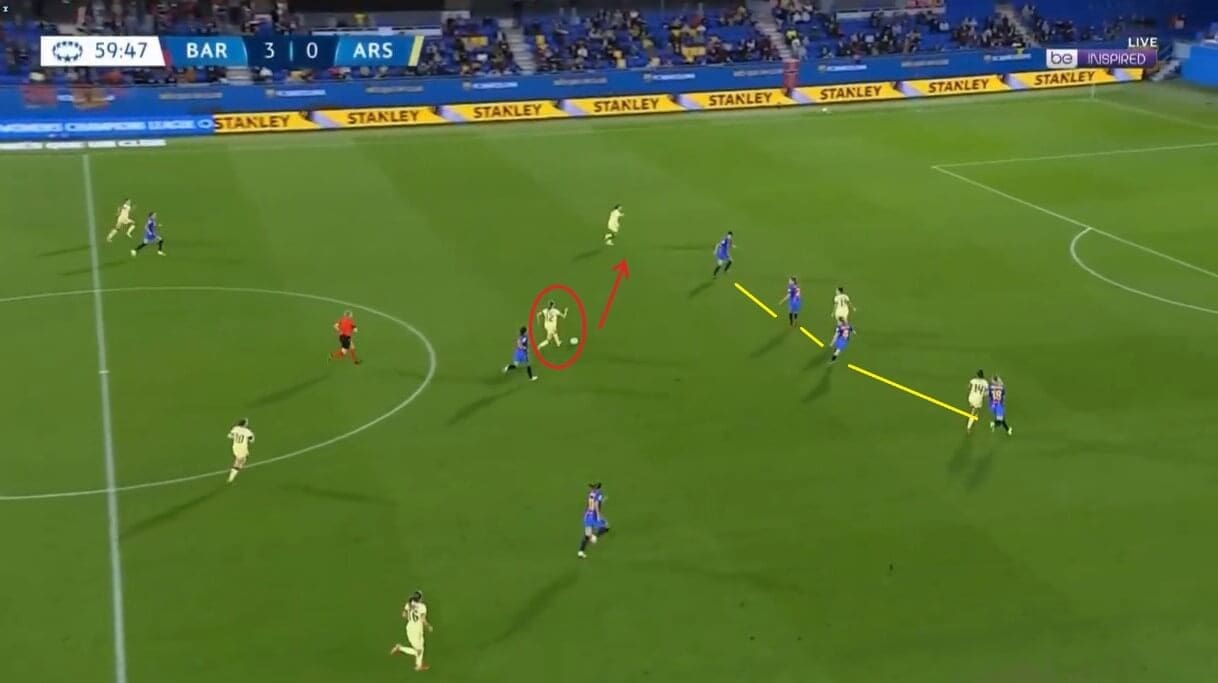
When they have possession, Barcelona make the pitch as big as possible, as has been evident on several occasions in this analysis. However, they instantly narrow once they lose possession and their opponents have begun to look upfield. Here, Arsenal’s Norway midfielder Frida Maanum is looking to access the space behind Barcelona’s defensive line, but the defenders’ compactness and line discipline make this hard to do. As a result, Maanum is forced to pass to a teammate outside the defensive line, increasing the distance that the ball needs to cover and giving Barcelona an opportunity to get out and win it back. Therefore, by staying tight in these situations, Barcelona can dictate how their opponents play, and that has been one key reason for their opponents finding it difficult to score against them during the current campaign.
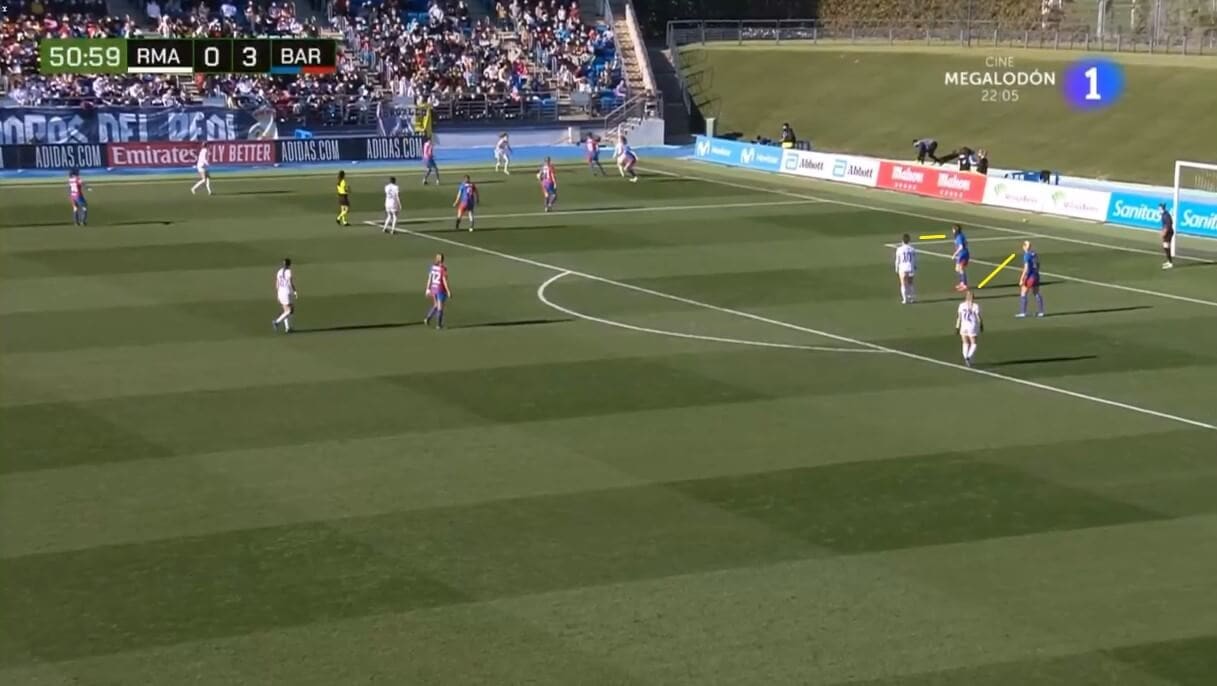
Whilst the whole defensive line is responsible for keeping attackers out, the two centre-backs have the most important job, as they are asked to track the opposing target players, ensuring that they don’t win the ball whenever it comes into the central spaces. This image shows how this works, with the two defenders marking one Real Madrid Femenino player each. However, it is not just a case of watching them; Barcelona also look to press their opponents whenever they do have the ball, forcing mistakes to be made on which they can capitalise. This is demonstrated in this situation, with Real Madrid striker Esther González meeting the eventual cross, but Andrea Pereira gets there and clears the danger. This is how Barcelona have ensured that their opponents have as few chances as possible to score against them.
With this being such a key part of their play, Giráldez has made sure that he has good central defensive options available to him. Mapi León and Andrea Pereira were the first choice pairing last season, but they have been joined over the summer by Spain captain Irene Paredes, who moved from PSG, whilst midfielder Patri Guijarro can also slot into the defence when needed. Giráldez hasn’t needed to change much in terms of their defensive playing style, as Barcelona already had a good desire to win the ball instilled in them by Cortés, so he has simply needed to add players and let them get on with the job, and that is also a sign of his good team management.
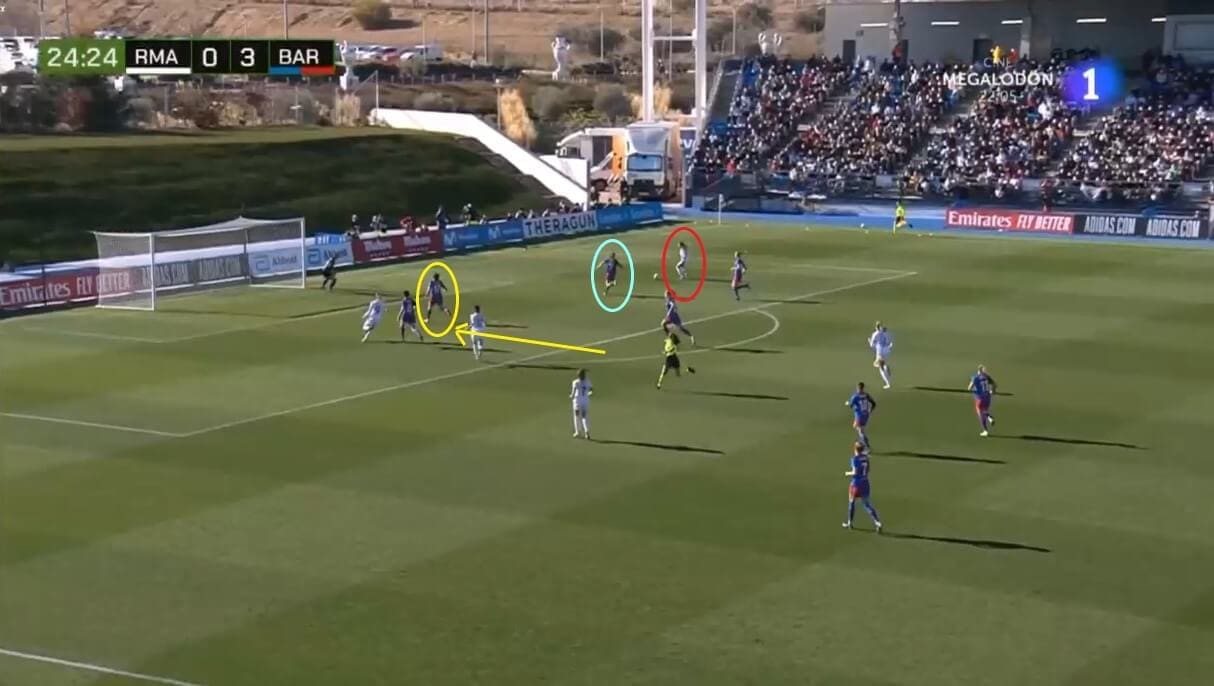
As well as their natural desire to win the ball, Barcelona’s defenders have a good awareness of their surroundings and position themselves where they can end threats effectively. Here, Real Madrid have moved into the box, with Barcelona’s four defenders again narrowly structured to cut off potential runners through the middle. However, there are attackers on the outside ready to get on the end of the ball and this is what Pereira has spotted. To block this off, she sees how her teammate has gone to close the ball down and adjusts her own run accordingly, moving into the space in front of goal from where she wins the ball and clears the danger for her team.
This shows great anticipation, and again, comes down to individual players knowing their roles at all times. Had Pereira either stayed back or joined her teammate in running towards the ball, the space would have been left open for Real Madrid to exploit. As with the previous image, Giráldez hasn’t needed to work on this too much, as a lot of it is pure instinct, but getting these small details right constantly has still been a key reason for Barcelona’s good form this season.
Conclusion
The purpose of this tactical analysis has been to highlight the preferred tactics of Barcelona Femení coach Jonatan Giráldez, and the way in which he has set his team up to be both watertight at the back and productive in the final third. We have analysed all three areas of the team, and it is clear that the reason they play well together is that each section is set up well and helps each other, and that comes down to Giráldez and the way he has coached them during the campaign. It is clear that the players are fully behind his ideas this season, and he and they will undoubtedly be ones to watch in 2022 to see just how far they can go.





Comments